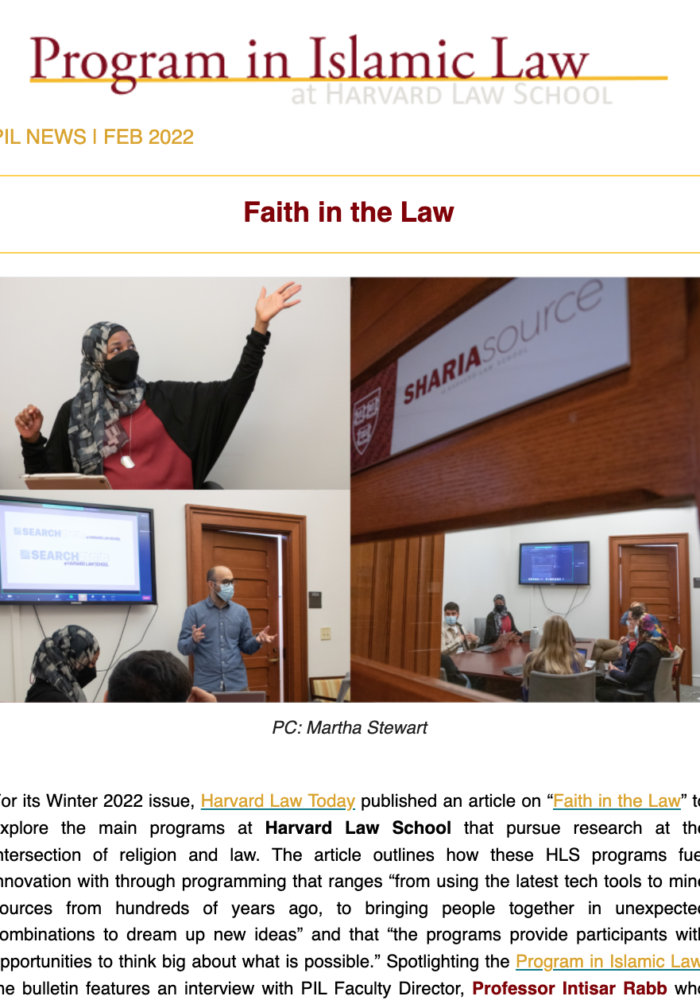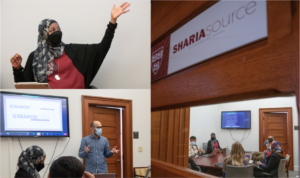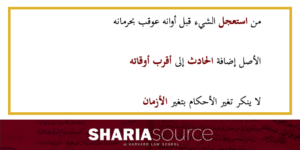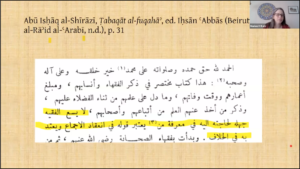
 Faith in the Law For its Winter 2022 issue, Harvard Law Today published an article on “Faith in the Law” to explore the main programs at Harvard Law School that pursue research at the intersection of religion and law. The article outlines how these HLS programs fuel innovation with through programming that ranges “from using the latest tech tools to mine sources from hundreds of years ago, to bringing people together in unexpected combinations to dream up new ideas” and that “the programs provide participants with opportunities to think big about what is possible.” Spotlighting the Program in Islamic Law, the bulletin features an interview with PIL Faculty Director, Professor Intisar Rabb who states that “The study of Islamic law is something of increasing consequence and importance for the study and understanding of law generally. For Harvard, which has a global footprint, these programs are an essential part of the school.” Pointing to SHARIAsource as PIL’s “flagship project,” PIL is notable for using artificial intelligence and data science to aid in the historical research of Islamic law and society. Of course, Professor Rabb notes, “AI and data science tools will never replace a researcher or a lawyer. But tools like the ones we are developing at the SHARIAsource Lab can help [each] navigate a vast and exciting array of history and texts as data. This can inform the research and conclusions that we’re able to make about the making and interpretation of law, about values behind law, and about social history surrounding existing law and new legal developments.” Read the full article today and explore our many resources.
Faith in the Law For its Winter 2022 issue, Harvard Law Today published an article on “Faith in the Law” to explore the main programs at Harvard Law School that pursue research at the intersection of religion and law. The article outlines how these HLS programs fuel innovation with through programming that ranges “from using the latest tech tools to mine sources from hundreds of years ago, to bringing people together in unexpected combinations to dream up new ideas” and that “the programs provide participants with opportunities to think big about what is possible.” Spotlighting the Program in Islamic Law, the bulletin features an interview with PIL Faculty Director, Professor Intisar Rabb who states that “The study of Islamic law is something of increasing consequence and importance for the study and understanding of law generally. For Harvard, which has a global footprint, these programs are an essential part of the school.” Pointing to SHARIAsource as PIL’s “flagship project,” PIL is notable for using artificial intelligence and data science to aid in the historical research of Islamic law and society. Of course, Professor Rabb notes, “AI and data science tools will never replace a researcher or a lawyer. But tools like the ones we are developing at the SHARIAsource Lab can help [each] navigate a vast and exciting array of history and texts as data. This can inform the research and conclusions that we’re able to make about the making and interpretation of law, about values behind law, and about social history surrounding existing law and new legal developments.” Read the full article today and explore our many resources.
 CONTENT: SHARIAsource Data Science Tools At SHARIASource we are developing various machine learning algorithms that will assist researches in semantically relating Islamic legal canons to one another. Extracting specific data from general texts is challenging in any project, especially one dealing with Arabic and other RTL texts. Even when we manage to extract the data, we still must resolve follow-on questions, such as: what patterns or thematic relationships connect the extracted data? In answering, we can examine thousands of “hits” from a general search to manually group them. Or, we can leverage advances in Artificial Intelligence and Machine Learning to cluster and group bits of texts as data in advance according to the semantic similarity. The illustration above shows our initial forays into the second approach. It shows three legal canons our ML model has clustered with a proposed shared theme of “time.” Explore our other data science tools today!
CONTENT: SHARIAsource Data Science Tools At SHARIASource we are developing various machine learning algorithms that will assist researches in semantically relating Islamic legal canons to one another. Extracting specific data from general texts is challenging in any project, especially one dealing with Arabic and other RTL texts. Even when we manage to extract the data, we still must resolve follow-on questions, such as: what patterns or thematic relationships connect the extracted data? In answering, we can examine thousands of “hits” from a general search to manually group them. Or, we can leverage advances in Artificial Intelligence and Machine Learning to cluster and group bits of texts as data in advance according to the semantic similarity. The illustration above shows our initial forays into the second approach. It shows three legal canons our ML model has clustered with a proposed shared theme of “time.” Explore our other data science tools today! CONTEXT: Monthly Islamic Legal Genres
CONTEXT: Monthly Islamic Legal Genres
See the full newsletter.

